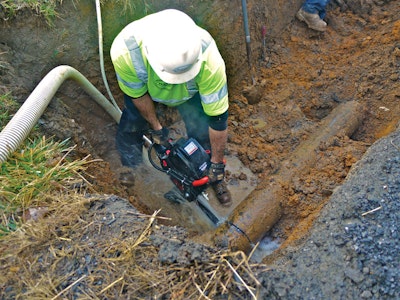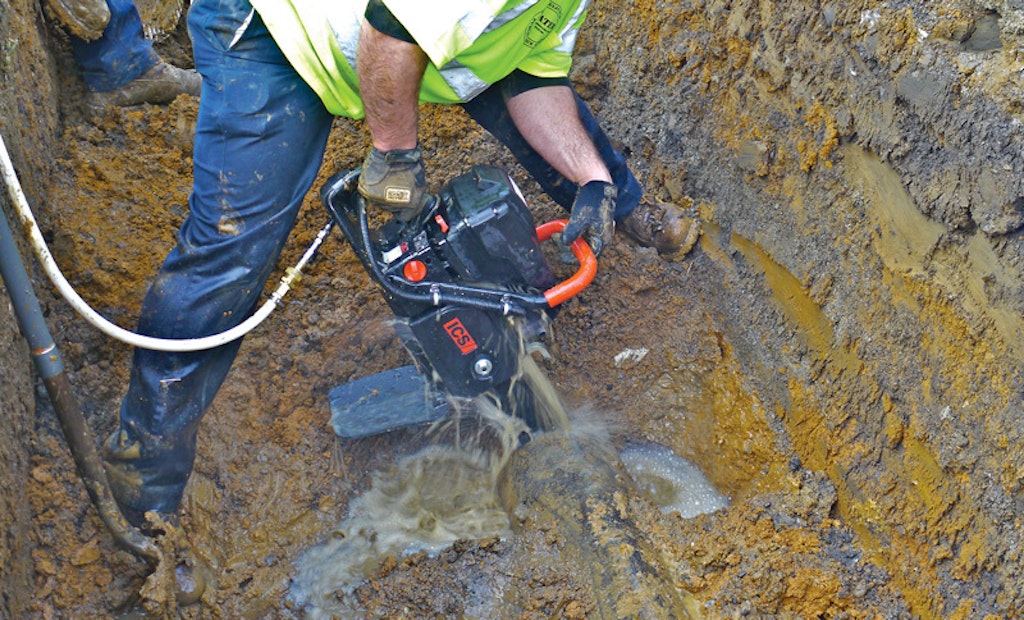The Berkeley County Public Service Water District in Martinsburg, W.Va., used gasoline-powered chop saws to repair and upgrade its 390 miles of 2- to 30-inch distribution piping. The maintenance staff began with abrasive blades, then switched to diamond blades, but the work was labor-intensive. Sawing most pipes took multiple cuts, and larger diameters required excavating on both sides and underneath the line.
Wayne Earhart, construction foreman, was always looking for faster, better ways to do things. When he read about the PowerGrit utility saw with diamond chain from ICS, Blount International, he asked a vendor for a demonstration. “I went with Brian Shade, our distribution superintendent,” says Earhart. “As soon as we used the saw, we wanted it. We put it in our budget and the day after the money arrived, we ordered it.”
Work crews found the saw more effective than the chop saws, easier and faster to use, and more maneuverable. The district has ordered a second unit.
Diamond studded
The 695F4 PowerGrit gasoline- fueled saw with 16-inch chain and bar cuts through ductile iron, PVC, cast iron, HDPE, cured-in-place pipes, and other hard materials without damaging them. The chain design gives users positive control of the saw and cut, helping them slice through pipe from one side without snagging or kickback.
The chain has drive links, rivets, support tie straps, and diamond grit tie straps. Its cutting surface is a braised layer of diamond segments laser-welded to a steel chassis. Although the chain is aggressive, its flat surface will not rip and tear. The only personal protective items required are safety glasses and hearing protection.
Water flowing through the guidebar lubricates and cools the chain while flushing slurry and grit from the chain and sprocket. The manufacturer recommends a minimum of 1 gpm/20 psi. If a water service or a fire hydrant is not near the repair site, a standard hose fitting on the saw enables workers to attach a garden hose or 3-gallon compression garden sprayer.
“We prefer the sprayer because a cut takes three to five gallons,” says Earhart. “Someone pumps continuously while the top cut is made, but once the saw breaks the surface, it has reached the water inside the line.”
The technology allows access to the entire cut from one position, reducing the size of excavations and making jobs easier. To cut around pipes larger than 12 inches, operators cut into the top, then plunge the saw down the opening and through the bottom of the invert. Using that cut as a fulcrum, they rotate the tool to finish the cut.
Substantially faster
The one-cut approach enabled district workers to saw around 10-inch ductile iron pipes in much less time than it took with the chop saws. “They’re averaging three or four minutes instead of 10 minutes,” says Earhart. “This method also eliminates jagged edges and binding of the blade.” As a test to see what the handheld saw could do, Earhart cut every hard material he could think of, and found that the tool never faltered.
In eight months of operating the saw, crews made more than 60 cuts with the initial chain. Its life expectancy, according to the manufacturer, is 20 to 40 cuts through 10-inch ductile iron pipe.
“The guidebar is supposed to last for one to three chains, but except for knocking off the paint, the original one shows hardly any wear,” says Earhart. “Keeping it well lubricated is the key.” Workers follow manufacturer recommendations and run the saw for a minute or two after making a cut to clean out tailings in the clutch and housing.
Routine maintenance involves changing the oil, filters, and spark plug. Adjusting the drive links when they hang more than one-half inch below the bar takes a minute. The operator loosens two bolts, adjusts the chain, and tightens the bolts. If he cannot pull the chain around the bar by hand, it is too tight.
“My guys love the saw and asked for more,” says Earhart. “The unit is very versatile, starts and runs dependably, and makes the job easier with less excavation.”
Shade adds, “This is a very good product. Being in the water industry for more than 20 years, it’s great to see equipment that actually works and performs as advertised.”







